DYB2011-Part-II-web
DYB2011-Part-II-web
DYB2011-Part-II-web
Create successful ePaper yourself
Turn your PDF publications into a flip-book with our unique Google optimized e-Paper software.
United Nations Disarmament Yearbook 2011: <strong>Part</strong> <strong>II</strong><br />
148<br />
• Arms Control Symposium (the Centre’s first arms control–related<br />
activity of this kind and at this level), which reflected on political<br />
ambitions to implement the existing arms control treaties, presented<br />
the latest developments in the field, and opened new perspectives on<br />
confidence-building measures for peace and stability in South-Eastern<br />
Europe; and<br />
• Conference entitled “Towards a Sustainable Solution for Excess<br />
Weapons and Ammunition: Policy, Logistical and Financial Aspects of<br />
Excess Weapons and Ammunition Disposal”, which served as a forum<br />
for raising the awareness on these topics and facilitating the process for<br />
finding a sustainable solution.<br />
South Eastern and Eastern Europe Clearinghouse for the Control of<br />
Small Arms and Light Weapons<br />
In 2011, the South Eastern and Eastern Europe Clearinghouse for the<br />
Control of Small Arms and Light Weapons (SEESAC) focused on upgrading<br />
SALW and ammunition storage facilities; conventional weapons and<br />
ammunition stockpile management training; destruction of SALW; weapons<br />
collection and awareness-raising campaigns; marking, tracing and registration<br />
of weapons; and arms exports control.<br />
The improvement of physical security and increased stockpile<br />
management capabilities through training and reconstruction of storage<br />
facilities represented a crucial contribution to SALW control in the region.<br />
Supported by European Union Council Decision 2010/179/CFSP 44, SEESAC<br />
activities resulted in the successful upgrade of the storage facilities named<br />
“Taras” in Montenegro and “Murat” in Croatia. Furthermore, preparatory<br />
work for the upgrade of four storage locations in Bosnia and Herzegovina<br />
took place.<br />
In terms of capacity development, SEESAC developed and implemented<br />
an extensive Regional Course on Stockpile Management with three modules<br />
and lasting 15 days. It was held in Bosnia and Herzegovina and was attended<br />
by representatives of the Ministries of Defence and Interior of Bosnia and<br />
Herzegovina, Croatia, Montenegro, Serbia and the former Yugoslav Republic<br />
of Macedonia. It resulted in a significantly increased capacity to plan, develop<br />
and manage stockpiles of conventional weapons and ammunition.<br />
SEESAC work was focused on directly assisting local authorities<br />
towards diminishing the risk of arms proliferation by significantly reducing<br />
the number of illegal, unwanted or surplus weapons in storage. Some of<br />
its activities included the destruction of 16,329 SALW in Croatia and<br />
several awareness-raising campaigns in Croatia and Serbia, supporting the<br />
Governments to properly disseminate information regarding the legalization<br />
and voluntary surrender of illegal firearms.


